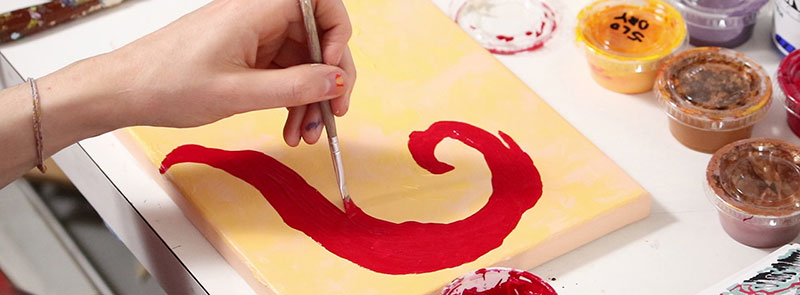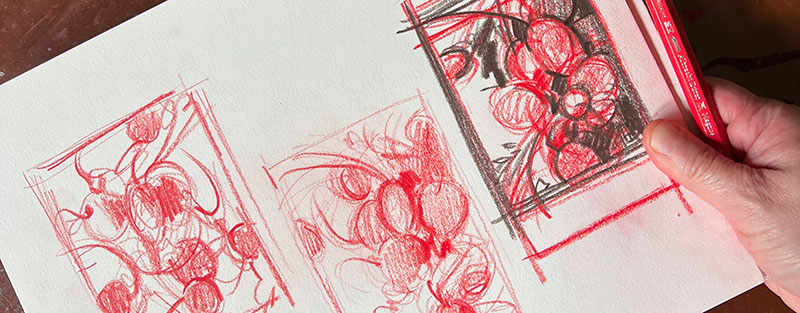Cold Calling as an artist can be an effective way to create professional opportunities for yourself.
This video explains how to research specific people to contact, the logistics of how to write an introductory email that is professional and succinct, and then how to follow up in a manner that is not intrusive or demanding.

Discussion led by Art Prof Clara Lieu and Teaching Artist Lauryn Welch.

Video Walkthrough
- Why should I Cold Call?
- Do your research
- Is this the right fit?
- Find artists who work in a similar style, who are in your field
- Follow those artists to stay up to date on your field
- Research similar artists’ resumes
- Find out where local artists exhibit
- Find a specific person
- Think bigger and broader
- Casual interactions via social media before the cold call
- Be patient, it can take a long time
- When can you add people to your email list?
- Writing emails: keep it short and sweet
- Always follow up
- Cast a wide net and keep your options open
Prof Lieu’s Tips

It’s true that the majority of art galleries, especially the ones that are high up on the food chain, won’t even look at an artist unless they have been recommended by another artist, curator, or dealer that they know personally.

In my experience, the best exhibition opportunities I’ve had were because someone I knew referred me to someone. It is extremely rare for me to apply for an exhibition, be chosen, and have it be a fruitful experience.

If you are at the beginning of your career, this situation makes it seem impossible to break into the right network of people.

As a gallery director, you get such an overwhelming amount of artist submissions, the majority of which aren’t even remotely appropriate for your venue.
Prof. Lieu
Before I worked as a gallery director, I never understood why this was the case and as an artist, felt that it was unfair.

Once I became a gallery director though, everything finally made sense to me. As a gallery director, you get such an overwhelming amount of artist submissions, the majority of which aren’t even remotely appropriate for your venue.
It was glaringly obvious to me when I did bother to look at the submissions that most of the artists who sent me their materials had absolutely no idea what our gallery’s primary focus was.

After the experience of wading through so many poor submissions, you start to realize why many galleries don’t even bother with artist submissions.
The likeliness that you’ll find quality work that fits your venue is so low, and even if you did like the work, there’s no guarantee that the artist would be professional and good to work with.

No one wants to waste their time working with an artist who is unpredictable or a pain. Most people prefer to work with an artist they personally know or who comes with a strong recommendation.

I have to admit that during the four years that I worked as a gallery director, I never once exhibited an artist who sent their materials to me unsolicited.

Check the gallery’s website to see if they accept artist submissions. If they do, send your materials exactly as specified on the website. Bear in mind though, that this process generally ends up with your submission in a black hole, never to be seen again.

If the website states that they do not accept artist submissions, I wouldn’t bother to send in your materials, as they will not be looked at.
Unfortunately, the vast majority of galleries, particularly the well established ones, do not review artist submissions.

Since this is the case, one can often feel paralyzed in terms of trying to break into the gallery scene.
Instead, work on raising your overall visibility in the local arts scene by showing in as many venues as possible; you never know who might be looking.

Try to have a show at an artist’s co-op or a gallery at an academic institution and get your work out that way.
Get to know other local artists, dealers, and curators. Attend local openings and lectures where you can meet other people in the art field in person.

Many dealers/curators will jury local competitions from time to time, so keep your eyes peeled for that and submit your work so the dealer/curator is sure to see it.
Eventually, your increased profile in the local arts community will earn you the contacts you need to get into a gallery.

Keep in mind that you won’t get results right away, and that it could be years before you gain the kind of exposure and contacts necessary to break into a gallery.
I’ve contacted curators in the past, and literally five years would go by, and then completely out of the blue they would contact me about a show.

Based on my experience with curators, it seems like they live in a completely different universe where time is at a completely different pace. I’ve always thought that what is one month to us equals one year in a curator’s terms.
Even if you do manage to break through and make personal contact with a gallery, remember that there’s no guarantee that your work will be accepted.

I once had a high profile Boston gallery dealer do a studio visit with me, only to be rejected by them a few weeks later. I had two curators, from a well known regional museum set up two studio visits with me over the course of three years.

I was excited that they seemed to have continued interest in my work, but then a few years later both curators left for positions elsewhere, so that lead died eventually.
Getting that close can be even more frustrating than being rejected right away! Situations like that make those quick rejections seem downright merciful by comparison.

I know it’s common to read about artists who are plucked right out of an MFA program and have this meteoric rise in the art world, but that’s practically the equivalent to winning the lottery.
For the rest of us, it’s an ongoing journey of persistence and tenacity that we have to keep working on; be prepared to be in this for the long haul.



